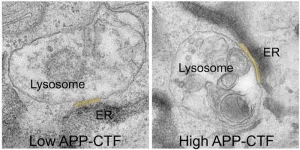(Press-News.org) A drug used to treat children with epilepsy prevents brain tumor formation and growth in two mouse models of neurofibromatosis type 1 (NF1), according to a study by researchers at Washington University School of Medicine in St. Louis. NF1 is a genetic condition that causes tumors to grow on nerves throughout the body, including the optic nerves, which connect the eyes to the brain.
The findings lay the groundwork for a clinical trial to assess whether the drug, lamotrigine, can prevent or delay brain tumors in children with NF1. The study is online in the journal Neuro-Oncology.
“Based on these data, the Neurofibromatosis Clinical Trials Consortium is considering launching a first-of-its-kind prevention trial,” said senior author David H. Gutmann, MD, PhD, the Donald O. Schnuck Family Professor of Neurology and the director of Washington University’s Neurofibromatosis Center. The clinical trials consortium is an international network of NF scientists that was formed by the U.S. Department of Defense in 2006 to find therapies for all forms of neurofibromatosis. “The plan is to enroll kids without symptoms, treat them for a limited time, and then see whether the number of children who develop tumors that require treatment goes down.
“This is a novel idea, so we took it to an NF1 patient focus group,” Gutmann continued. “They said, ‘This is exactly what we’re looking for.’ A short-term treatment with a drug that has been used safely for 30 years was acceptable to them if it reduced the chance their children would develop tumors and need chemotherapy that might have all kinds of side effects.”
The most serious tumors that people with NF1 get affect the optic nerve and are known as optic gliomas. Such tumors typically appear between ages 3 to 7. While they are rarely fatal, they cause vision loss in up to a third of patients as well as other symptoms, including early puberty. Standard chemotherapy for optic gliomas is only moderately effective at preventing further vision loss and can affect children’s developing brains, resulting in cognitive and behavioral problems.
In a previous study, Gutmann and Corina Anastasaki, PhD, an assistant professor of neurology and the first author on the new paper, showed that lamotrigine stopped optic glioma growth in NF1 mice by suppressing neuronal hyperactivity. The Neurofibromatosis Clinical Trial Consortium found their data intriguing but demanded more evidence before they would consider launching a clinical trial. The consortium members asked Gutmann and Anastasaki to clarify the connection between Nf1 mutation, neuronal excitability and optic gliomas; assess whether lamotrigine was effective at the doses already proven safe in children with epilepsy; and conduct these studies in more than one strain of NF1 mice.
In people, NF1 is a highly variable disease. It can be caused by any one of thousands of different mutations in the NF1 gene, where different mutations could be associated with different medical problems. Repeating experiments in multiple strains of mice was a way of gauging whether lamotrigine was likely to work in people regardless of the underlying mutation.
Anastasaki and Gutmann not only showed that lamotrigine worked in two strains of NF1 mice, they also showed that the drug worked at lower doses than those used for epilepsy, meaning that it was probably safe. Even better, they found that a short course of the drug had lasting effects, both as a preventive and a treatment. Mice that had tumors and that were treated for four weeks starting at 12 weeks of age saw their tumors stop growing and even showed no further damage to the retinas of their eyes. Mice that received a four-week course of the drug starting at 4 weeks of age, before tumors typically emerge, showed no tumor growth even four months after treatment had ended.
These findings have led Gutmann to suggest that a one-year course of treatment for young children with NF1, maybe between the ages of 2 to 4, might be enough to reduce their risk of brain tumors.
“The idea that we might be able to change the prognosis for these kids by intervening within a short time window is so exciting,” Gutmann said. “If we could just get them past the age when these tumors typically form, past age 7, they may never need treatment. I’d love it if I never again had to discuss chemotherapy for kids who aren’t even in first grade yet.”
END
Epilepsy drug prevents brain tumors in mice with NF1
Study lays groundwork for clinical trial aimed at preventing brain tumors in children with NF1
2024-04-15
ELSE PRESS RELEASES FROM THIS DATE:
Study uses thermodynamics to describe expansion of the Universe
2024-04-15
The idea that the Universe is expanding dates from almost a century ago. It was first put forward by Belgian cosmologist Georges Lemaître (1894-1966) in 1927 and confirmed observationally by American astronomer Edwin Hubble (1889-1953) two years later. Hubble observed that the redshift in the electromagnetic spectrum of the light received from celestial objects was directly proportional to their distance from Earth, which meant that bodies farther away from Earth were moving away faster and the universe must be expanding.
A surprising new ingredient was added to the model in 1998 when observations of ...
New mechanism uncovered in early stages of Alzheimer's disease
2024-04-15
Leuven (Belgium), 16 April 2024 – Alzheimer's disease (AD) remains one of the most challenging and prevalent neurodegenerative disorders, affecting millions of individuals worldwide. In a new study published in Developmental Cell, researchers from the lab of Wim Annaert (VIB-KU Leuven) have identified a novel mechanism potentially connected to the early stages of AD. They demonstrated that a fragment of the amyloid precursor protein (APP), called APP-CTF, disrupts communication between cellular compartments crucial for calcium storage and waste disposal, which ...
Elite coaches leaving home as Western countries seek sport success
2024-04-15
Nations battling for Olympic success in a global sporting ‘arms race’ has led to elite coaches migrating to Western countries as they bid to escape antiquated and restrictive coaching regimes in their home countries, reveals a new study funded by the International Olympic Committee’s Olympic Studies Centre.
National teams pursuing Olympic gold medals are increasingly recruiting foreign elite coaches from the leading countries, as they try to close the gap between themselves and the top medal-winners in particular ...
Millions of gamers advance biomedical research
2024-04-15
Leveraging gamers and video game technology can dramatically boost scientific research according to a new study published today in Nature Biotechnology.
4.5 million gamers around the world have advanced medical science by helping to reconstruct microbial evolutionary histories using a minigame included inside the critically and commercially successful video game, Borderlands 3. Their playing has led to a significantly refined estimate of the relationships of microbes in the human gut. The results of this collaboration will both substantially advance our knowledge of the microbiome ...
Global North energy outsourcing demands more attention
2024-04-15
Manufacturing nations in the Global North are stockpiling energy and emission problems by outsourcing energy-intensive industrial processes to countries in the Global South, a new study reveals.
Global North countries use their advantages in capital and technology to grab a large amount of energy through outsourcing - creating a ‘false decoupling’ of energy consumption from economic growth.
But backward production technologies in the Global South tend to result in more energy consumption per unit of output – leading to greater carbon emissions ...
Mayo researchers invented a new class of AI to improve cancer research and treatments
2024-04-15
ROCHESTER, Minnesota — Mayo Clinic researchers recently invented a new class of artificial intelligence (AI) algorithms called hypothesis-driven AI that are a significant departure from traditional AI models which learn solely from data.
In a review published in Cancers, the researchers note that this emerging class of AI offers an innovative way to use massive datasets to help discover the complex causes of diseases such as cancer and improve treatment strategies.
"This fosters a new era in designing targeted and informed AI algorithms to solve scientific questions, ...
Machine learning could help reveal undiscovered particles within data from the Large Hadron Collider
2024-04-15
Scientists used a neural network, a type of brain-inspired machine learning algorithm, to sift through large volumes of particle collision data.
Particle physicists are tasked with mining this massive and growing store of collision data for evidence of undiscovered particles. In particular, they’re searching for particles not included in the Standard Model of particle physics, our current understanding of the universe’s makeup that scientists suspect is incomplete.
As part of the ATLAS collaboration, scientists ...
metaphacts and Dimensions launch the Dimensions Knowledge Graph, powered by metaphactory
2024-04-15
Digital Science solutions metaphacts and Dimensions are excited to announce the highly anticipated launch of the Dimensions Knowledge Graph, a large ready-made knowledge graph powering AI solutions in the pharmaceutical and life sciences industries.
The Dimensions Knowledge Graph, powered by metaphactory, is an all-in-one knowledge graph solution, ready-made for easy integration with customers’ data infrastructure and existing internal knowledge graphs. At its core is an explicitly defined and flexible semantic model that can be easily extended to include internal data (which can range from domain expert knowledge or data from internal documents) ...
Parent perceptions of school meals influence student participation in school meal programs
2024-04-15
Philadelphia, April 15, 2024 – Since the implementation of the Healthy, Hunger-Free Kids Act in 2010, school meals in the United States have significantly improved. Several factors have been reported to impact student participation in school meals, including parental perceptions of school breakfast and lunch. A recent research article in the Journal of Nutrition Education and Behavior, published by Elsevier, assessed the association between parent perspectives on the school meal program and student participation.
Researcher ...
Hydrogen recombination found to be most plausible explanation for high levels of energy in stellar superflares
2024-04-15
Although their primary purpose is to look for exoplanets, observatories like the Kepler Space Telescope and the Transiting Exoplanet Survey Satellite (TESS) have supplied a vast amount of data on stellar flares, detected with high-precision photometry by broadband filters in the visible light spectrum.
The stars are so far away that they appear only as points of light to these telescopes, and the phenomena interpreted as stellar flares are abrupt increases in the brightness of these points.
There is also a lack of data in other parts of the electromagnetic spectrum, and most studies of these events focus on irradiated ...
LAST 30 PRESS RELEASES:
University of Oklahoma researcher awarded funding to pursue AI-powered material design
Exploring how the visual system recovers following injury
Support for parents with infants at pediatric check-ups leads to better reading and math skills in elementary school
Kids’ behavioral health is a growing share of family health costs
Day & night: Cancer disrupts the brain’s natural rhythm
COVID-19 vaccination significantly reduces risk to pregnant women and baby
The role of vaccination in maternal and perinatal outcomes associated with COVID-19 in pregnancy
Mayo Clinic smartwatch system helps parents shorten and defuse children's severe tantrums early
Behavioral health spending spikes to 40% of all children’s health expenditures, nearly doubling in a decade
Digital cognitive behavioral treatment for generalized anxiety disorder
Expenditures for pediatric behavioral health care over time and estimated family financial burden
Air conditioning in nursing homes and mortality during extreme heat
The Alps to lose a record number of glaciers in the next decade
What makes a good proton conductor?
New science reporting guide published for journalists in Bulgaria
New international study reveals major survival gaps among children with cancer
New science reporting guide published for journalists in Turkey
Scientists develop a smarter mRNA therapy that knows which cells to target
Neuroanatomy-informed brain–machine hybrid intelligence for robust acoustic target detection
Eight SwRI hydrogen projects funded by ENERGYWERX
The Lundquist Institute and its start-up company Vitalex Biosciences Announces Strategic Advancement of Second-Generation fungal Vaccine VXV-01 through Phase 1 Trials under $40 Million Competitive Con
Fine particles in pollution are associated with early signs of autoimmune disease
Review article | Towards a Global Ground-Based Earth Observatory (GGBEO): Leveraging existing systems and networks
Penn and UMich create world’s smallest programmable, autonomous robots
Cleveland researchers launch first major study to address ‘hidden performance killer’ in athletes
To connect across politics, try saying what you oppose
Modulating key interaction prevents virus from entering cells
Project explores barriers to NHS career progression facing international medical graduates
Jeonbuk National University researchers explore the impact of different seasonings on the flavor perception of Doenjang soup
Two Keck Medicine of USC Hospitals named Leapfrog Top Teaching Hospitals
[Press-News.org] Epilepsy drug prevents brain tumors in mice with NF1Study lays groundwork for clinical trial aimed at preventing brain tumors in children with NF1



